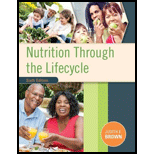
Nutrition Through the Life Cycle (MindTap Course List)
6th Edition
ISBN: 9781305628007
Author: Judith E. Brown
Publisher: Cengage Learning
expand_more
expand_more
format_list_bulleted
Concept explainers
Question
Chapter 8, Problem 7RQ
Summary Introduction
Introduction: Complementary food is usually included in dietary plans to assist balanced nutritional benefits. These include semisolids, liquid, and solids that needed to be introduced in the diet of an infant besides breast milk or formula milk, usually after the six months of age. A complementary food provides the essential nutrients that are required for the growth and development of the infant, but have to be selected carefully in order to avoid the advent of untoward nutritional imbalance.
Expert Solution & Answer
Want to see the full answer?
Check out a sample textbook solution
Chapter 8 Solutions
Nutrition Through the Life Cycle (MindTap Course List)
Knowledge Booster
Learn more about
Need a deep-dive on the concept behind this application? Look no further. Learn more about this topic, health-nutrition and related others by exploring similar questions and additional content below.Similar questions
- Along the lines of question 3, formulate a healthy diet for an actively growing 7-year-old.arrow_forwardWhich is a true statement about limiting nutrients in infancy? a. Iron supplementation is initiated when infants are six months of age. b. Vitamin D supplementation is needed in breastfed infants because the content is low in breast milk. c. Low intake of dietary fiber is a common cause of constipation in infants. d. Fluoride is not needed until teeth start erupting in late infancy.arrow_forward
Recommended textbooks for you
 Nutrition Through the Life Cycle (MindTap Course ...Health & NutritionISBN:9781305628007Author:Judith E. BrownPublisher:Cengage Learning
Nutrition Through the Life Cycle (MindTap Course ...Health & NutritionISBN:9781305628007Author:Judith E. BrownPublisher:Cengage Learning Nutrition Through The Life CycleHealth & NutritionISBN:9781337919333Author:Brown, Judith E.Publisher:Cengage Learning,
Nutrition Through The Life CycleHealth & NutritionISBN:9781337919333Author:Brown, Judith E.Publisher:Cengage Learning,

Nutrition Through the Life Cycle (MindTap Course ...
Health & Nutrition
ISBN:9781305628007
Author:Judith E. Brown
Publisher:Cengage Learning

Nutrition Through The Life Cycle
Health & Nutrition
ISBN:9781337919333
Author:Brown, Judith E.
Publisher:Cengage Learning,



